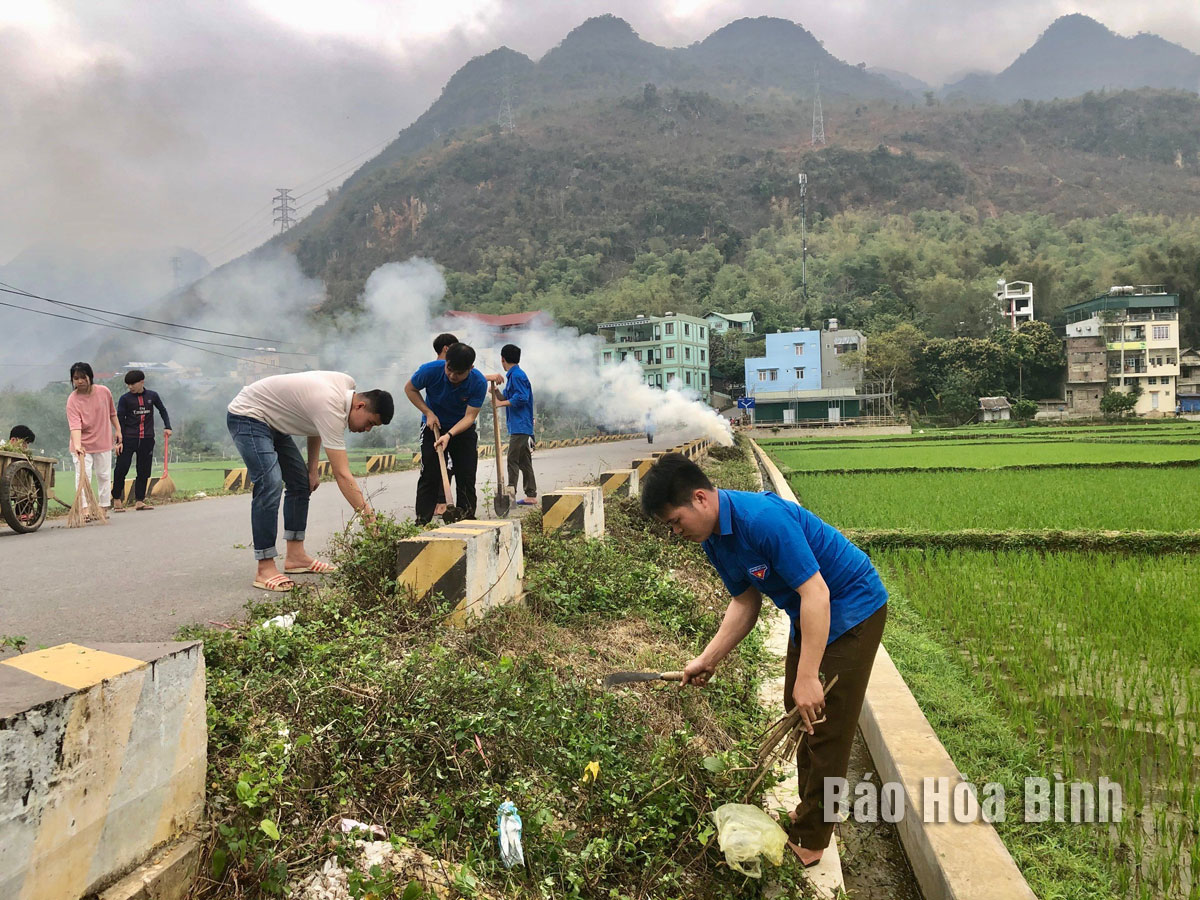
The World Environment Day (June 5), launched by the UN Environment Programme, has been celebrated in Vietnam since 1982 and become a nationwide movement, helping raise public awareness of environmental protection, biodiversity conservation, sustainable development, and climate change response. This year, the day is themed "Land restoration, desertification and drought resilience”. All-level Party Committees and administrations in Hoa Binh province continue to view improving awareness, restoring land, and fighting drought and desertification as an indispensable part of the socio-economic development plan and an important task during the sustainable development process.
Young people in Chieng Chau commune, Mai Chau district, clean up a road to Lac village.
According to the provincial People’s Committee, natural disasters caused losses worth over 129 billion VND (5 million USD) in Hoa Binh in 2023. In particular, prolonged and widespread heat last year resulted in water levels of many local rivers and springs falling down to below the dead level. This situation may repeat in 2024 as the province’s hydro-meteorological station forecast strong heats will continue this summer, posing risk of widespread drought and water shortage.
Pham Thi Hoa, head of the environmental protection division, said risks of land erosion, drought, and desertification have never been so obvious like at present. This year’s World Environment Day is themed "Land restoration, desertification and drought resilience” to appeal to countries around the globe to work together to restore land, fight desertification, and improve drought resilience, thus slowing down climate change, protecting the nature, and improving livelihoods and food security for billions of people worldwide.
Viewing environmental protection as a foundation, focal factor, and prerequisite for sustainable economic development, Hoa Binh is pressing on with comprehensive solutions to protect the environment and cope with climate change.
In particular, it is stepping up the implementation of the 2020 Law on Environmental Protection and the document guiding the implementation of the law; the Government and the province’s programmes, resolutions, decisions, and directives on active response to climate change, environmental protection, and greenhouse gas emission reduction; measures for responding to heat, drought, water shortages, and saltwater intrusion; along with carbon credit management.
Local authorities are reviewing and monitoring the land environment quality; building and implementing plans to treat and restore polluted land areas; and devising measures for prenventing and minimising drought and desertification.
Coordination is being enhanced among all-level authorities, sectors, and localities while conditions are created for locals to access anti-drought and desertification information and techniques.
Efforts are being stepped up to protect and develop forests, efficiently use land resources, develop livelihoods for residents in desertifying areas and those at risk of desertification. Advanced solutions are also being considered and applied to efficiently use water resources and protect land surface.
Besides, Hoa Binh is working to improve public awareness. It identifies land restoration and drought and desertification prevention as an indispensable part of the socio-economic development plan and also an important task during the sustainable development process.
The province will also expand effective models of land restoration and drought and desertification prevention, especially in the areas directly affected by natural phenomena.
More than just an information technology teacher, Bui Van Nien is an inspiring figure who has nurtured the scientific curiosity and creative spirit of students in Vietnam’s ethnic minority communities.
Da Bac is the most disadvantaged mountainous district in Hoa Binh province, with ethnic minorities accounting for about 90% of its population. Over the past years, the district has mobilised resources to implement ethnic policies to improve the quality of life of local people.
In recent years, Hoa Binh province has consistently prioritised the protection, care, and education of children, particularly those from ethnic minorities and disadvantaged backgrounds, by creating a safe, healthy, and nurturing environment for their all-round development.
The Steering Committee for Tobacco Harm Prevention and Control of Hoa Binh province, in coordination with the Tobacco Harm Prevention and Control Fund, held a ceremony on May 28 in response to the World No Tobacco Day (May 31) and the National No Tobacco Week (from May 25 to 31). The event was chaired by Nguyen Van Toan, Standing Vice Chairman of the provincial People’s Committee and head of the Steering Committee.
Since 2021, the Center for Industrial Promotion and Industrial Development Consulting (CIIDC) under the Department of Industry and Trade has been implementing a school lighting model as part of the plan for using energy efficiently and economically in Hoa Binh Province in the pẻiod of 2021 - 2025. This model not only aims to improve the learning conditions and enhance the education quality, but it also promotes the message of energy saving, energy security, environmental protection and contributes to the goals of socio-economic development.
In the 2024 - 2025 school year, the entire Hoa Binh provincial education sector includes 520 educational institutions and schools. Among them are 13 ethnic boarding schools with 153 classes and 4,487 students. Four of these schools have met national standards, reaching 30.7 percent.



